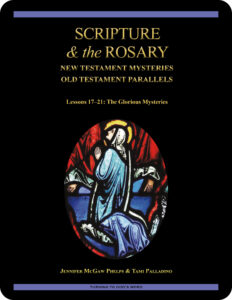 Scripture & the Rosary:
Scripture & the Rosary:
New Testament Mysteries,
Old Testament Parallels
The Fifth Glorious Mystery
Lesson 21 A Woman Clothed with the Sun
the book of Revelation 11:19—12:6
the Book of Esther 8:3–8
Revised Standard Version Catholic Edition (RSVCE)*
New American Bible Revised Edition (NABRE)*
Catechism of the Catholic Church
Rosarium Virginis Mariae (Rosary of the Virgin Mary)
ex libris (in our library)
cross references for Scripture & the Rosary
next lesson: He Saw the Spirit of God Descending
This material coordinates with Lesson 21 on pages 80–83 in Scripture & the Rosary: New Testament Mysteries, Old Testament Parallels.
And Mary said, “My soul magnifies the Lord, and my spirit rejoices in God my Savior,
for he has regarded the low estate of his handmaiden.
For behold, henceforth all generations will call me blessed;
for he who is mighty has done great things for me, and holy is his name.”
—the Gospel According to Luke 1:46–49
welcome to our in-depth study of Scripture & the Rosary
We invite groups and individuals to become acquainted with Turning to God’s Word Catholic Bible  studies through
studies through  Scripture & the Rosary: New Testament Mysteries, Old Testament Parallels, which has been granted an imprimatur. Although no longer available in print, the first six lessons can be downloaded from our website. The remaining 20 lessons are posted throughout the liturgical year along with their related online study pages. Click here to access Lesson 17 through Lesson 21. If you have a Bible-study question or comment, you can contact our authors any time by using one of the “ask us your question” or “what do you think” buttons on any online study page.
Scripture & the Rosary: New Testament Mysteries, Old Testament Parallels, which has been granted an imprimatur. Although no longer available in print, the first six lessons can be downloaded from our website. The remaining 20 lessons are posted throughout the liturgical year along with their related online study pages. Click here to access Lesson 17 through Lesson 21. If you have a Bible-study question or comment, you can contact our authors any time by using one of the “ask us your question” or “what do you think” buttons on any online study page.
open with prayer
It’s always wise to begin any Bible study with prayer, whether reading the Scriptures alone or meeting with others in a discussion group. You can pray using your own words or use one of the opening prayers on our website. We especially like the following:
Lord Jesus, you promised to send your Holy Spirit to teach us all things.
As we read and study your word today,
allow it to touch our hearts and change our lives. Amen.
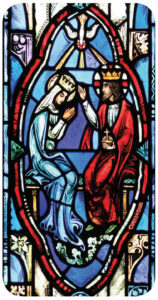 making connections—Queen Mary & Queen Esther
making connections—Queen Mary & Queen Esther
Lesson 21 in Scripture & the Rosary: New Testament Mysteries, Old Testament Parallels looks at the final Glorious Mystery, the Coronation of the Blessed Virgin Mary. The New Testament text is taken from the last book of the New Testament, the book of Revelation 11:19—12:6, which describes an apocalyptic Christian view of heaven based on prophecies found in the Old Testament. The Old Testament parallel text for this lesson is the account of  the coronation of Esther, which can be found in the Book of Esther 8:3–8. The Turning to God’s Word Catholic Bible study The Revelation of Jesus Christ: The Faithful Witness examines the challenging and somewhat bizarre images that are found in the final book of the Bible.
the coronation of Esther, which can be found in the Book of Esther 8:3–8. The Turning to God’s Word Catholic Bible study The Revelation of Jesus Christ: The Faithful Witness examines the challenging and somewhat bizarre images that are found in the final book of the Bible.
let’s look at the new in the light of the old
As you read through this lesson’s selected passages from the New and Old Testaments, ask yourself what these two biblical accounts have in common. Additional in-depth questions can be found on pages 80–83 in Scripture & the Rosary: New Testament Mysteries, Old Testament Parallels. Clicking on the New and Old Testament stained glass windows will enlarge the art. The same art also illustrates Lesson 21 in Scripture & the Rosary: New Testament Mysteries, Old Testament Parallels.
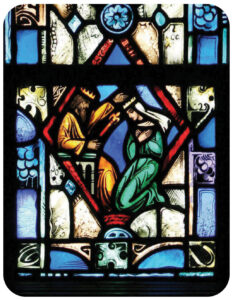 ? How do the lives of the Blessed Virgin Mary and Esther differ?
? How do the lives of the Blessed Virgin Mary and Esther differ?
? What personality characteristics might the Blessed Virgin Mary and the Old Testament heroine Esther have in common?
? What request does Esther make of the king, and on whose behalf?
? Who benefits from Esther’s request?
? Who suffers as a result of Esther’s request?
? What does the Old Testament account of Esther suggest about the Blessed Virgin Mary’s role as Queen of Heaven?
? What requests might the Blessed Virgin Mary be making of the King of Heaven?
 ? The Salve Regina (Hail, Holy Queen) is a traditional Catholic prayer that specifically honors Mary as a queen. What do Christians ask of the Blessed Virgin in that prayer?
? The Salve Regina (Hail, Holy Queen) is a traditional Catholic prayer that specifically honors Mary as a queen. What do Christians ask of the Blessed Virgin in that prayer?
? Look at the pictures of the stained glass window panels on pages 80 and 82 in Scripture & the Rosary: New Testament Mysteries, Old Testament Parallels. What similarities do you see between the depictions of these New and Old Testament scenes?
supplemental Scripture
The only clear image of the Blessed Virgin Mary to be found in the book of Revelation appears in the twelfth chapter,  but familiarity with the entire final book of the Bible can shed more light on Mary’s role as Queen of Heaven. Knowledge of Old Testament types of Mary also will be helpful, especially Bathsheba in her role as the Queen Mother in Solomon’s court. The Turning to God’s
but familiarity with the entire final book of the Bible can shed more light on Mary’s role as Queen of Heaven. Knowledge of Old Testament types of Mary also will be helpful, especially Bathsheba in her role as the Queen Mother in Solomon’s court. The Turning to God’s  Word Catholic Bible study The United Kingdom of Israel: Saul, David & Solomon Foreshadow Christ the King provides more information about the lives of Saul, David, and Solomon and how they relate to present-day Christianity. More background can be found by reading the First Book of the Kings and the First Book of the Chronicles. Familiarity with the entire Old Testament Book of Esther also is recommended.
Word Catholic Bible study The United Kingdom of Israel: Saul, David & Solomon Foreshadow Christ the King provides more information about the lives of Saul, David, and Solomon and how they relate to present-day Christianity. More background can be found by reading the First Book of the Kings and the First Book of the Chronicles. Familiarity with the entire Old Testament Book of Esther also is recommended.
where do we think that Mary belongs?
Many people have difficulty understanding the place of the Blessed Virgin Mary in the hearts of Christians. While it can be helpful to remember the important role held by the Queen Mother in the ancient world, it’s also incumbent upon Christians who struggle with Mary’s role in the Church to pray to Jesus and ask him to grant them more understanding regarding his Mother.
WHAT DO YOU THINK of the Blessed Virgin Mary as your spiritual mother?
People who have had a difficult relationship with their own mother often have a psychological stumbling block when it comes to honoring the Blessed Virgin Mary. If someone hasn’t experienced a mother’s love, that person can be distrustful of the love that Jesus’ Mother offers to all of God’s children. If you’re such a person, it can take time and patience to overcome deep-seated ideas rooted in your childhood experience. In the meantime, try to do whatever you feel comfortable doing to honor the Blessed Virgin. If, on the other hand, you’re someone who easily relates to the Blessed Virgin, pray for her guidance so that you can help others learn to accept her as Mother of the Church.
 ? Consider whether you think of the Blessed Virgin Mary in personal terms as a strong maternal influence in your spiritual life. Why or why not?
? Consider whether you think of the Blessed Virgin Mary in personal terms as a strong maternal influence in your spiritual life. Why or why not?
? How do you think it is that being on close terms with Jesus’ Mother is of spiritual benefit to Christians?
? What can you do to develop a more intimate relationship with Jesus’ Mother?
? How would you go about helping someone struggling to relate to Mary?
 glory—you could look it up in our archives
glory—you could look it up in our archives
The fifth glorious mystery of the Rosary focuses on the Blessed Virgin sharing her Son’s glory in heaven. To learn how this mystery rests on an understanding of “glory” and light, read Lost in Translation, an online column in which Turning to God’s Word author Matthew Phelps helps readers connect with ideas expressed in the original languages of the Scriptures. New Lost in Translation entries are posted on Mondays, and past entries are archived on our website. Contact us if you’d like to receive Lost in Translation by email every week.
do you know the spiritual fruit associated with the Fifth Glorious Mystery?
Hint: It often is considered to be particularly Catholic in nature. You can find out what it is in the “Fruits of Prayer” box on page 81 in Scripture & the Rosary: New Testament Mysteries, Old Testament Parallels. In what ways might this fruit benefit you in your everyday life?
 the best Catholic commentary about Scripture
the best Catholic commentary about Scripture
To find out more about how Church teaching is supported by passages in Scripture & the Rosary: New Testament Mysteries, Old Testament Parallels, check out the Index of Citations in the Catechism of the Catholic Church. Links (Revised Standard Version Catholic Edition [RSVCE*]) to the primary Scripture passages in the lesson and relevant paragraphs in the Catechism are provided here. Not every passage in the biblical text for this study is referenced in a Catechism paragraph, however, including the passage in this lesson from the Book of Esther 8:3–8.
the book of Revelation 12:1–17—paragraph 1138
to learn more, read more Scripture
When you’re having difficulty understanding a passage of Scripture, it can help to read the  cross references—but looking these up takes time. We’ve compiled the cross references from the Revised Standard Version Second Catholic Edition (RSV2CE)—the same translation that we reprint in our study books. The list can be found at the top of every online study page, and it includes links to cross references in the primary biblical texts for all of the lessons in Scripture and the Rosary; New Testament Mysteries, Old Testament Parallels.
cross references—but looking these up takes time. We’ve compiled the cross references from the Revised Standard Version Second Catholic Edition (RSV2CE)—the same translation that we reprint in our study books. The list can be found at the top of every online study page, and it includes links to cross references in the primary biblical texts for all of the lessons in Scripture and the Rosary; New Testament Mysteries, Old Testament Parallels.
don’t forget about our indexes & extra online material

 If you’re trying to locate information about a Scripture passage, you can look it up in the index at the back of the online version of this study. If you want to revisit a commentary, you can look it up by title in the topics index. If you want to learn more about another book of the Bible for which there’s a Turning to God’s Word study, you can read online commentaries and watch any accompanying videos by choosing a lesson from one of the study directories. (There are no lesson videos with Scripture & the Rosary: New Testament Mysteries, Old Testament Parallels.) Finally, if you have a question or would like to make a comment about any of our studies, you can use the “ask us your question” or “what do you think” button to email our authors.
If you’re trying to locate information about a Scripture passage, you can look it up in the index at the back of the online version of this study. If you want to revisit a commentary, you can look it up by title in the topics index. If you want to learn more about another book of the Bible for which there’s a Turning to God’s Word study, you can read online commentaries and watch any accompanying videos by choosing a lesson from one of the study directories. (There are no lesson videos with Scripture & the Rosary: New Testament Mysteries, Old Testament Parallels.) Finally, if you have a question or would like to make a comment about any of our studies, you can use the “ask us your question” or “what do you think” button to email our authors.
ex libris—Church documents & books about religious topics
Link to magisterial documents referred to in our Bible studies at ex libris—magisterial documents.  This listing includes significant recent encyclicals as well as a number of historical Church documents. Recommended books related to Scripture study can be found at ex libris—main bookshelf.
This listing includes significant recent encyclicals as well as a number of historical Church documents. Recommended books related to Scripture study can be found at ex libris—main bookshelf.
wondering how to pronounce some of these words?
The following links are to readings from the New International Version (NIV) Bible. To listen, click on the audio icon above the printed text. Although not taken from the translations used in our study materials, the NIV readings provide an audio guide to pronunciation of words in this lesson’s primary biblical texts. A close online version of the translation of the Bible used in Catholic liturgy in the United States as well as an audio guide for daily Mass readings for the current month can be found on the website of the United States Conference of Catholic Bishops (USCCB).
the book of Revelation 11:19—12:6 (NIV)
the Book of Esther 8:3–8 (NIV)
close by praying the Fifth Glorious Mystery
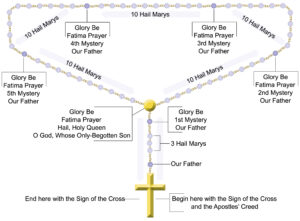 Many of our study groups like to conclude discussions of Scripture & the Rosary: New Testament Mysteries, Old Testament Parallels by praying a decade of the Rosary devoted to the Mystery that’s the focus of their lesson. A number of Catholics include a request for an increase in the spiritual fruit associated with the mystery. You can find out what’s associated with the Fifth Glorious Mystery in the “Fruits of Prayer” box on page 81 in Scripture & the Rosary: New Testament Mysteries, Old Testament Parallels.
Many of our study groups like to conclude discussions of Scripture & the Rosary: New Testament Mysteries, Old Testament Parallels by praying a decade of the Rosary devoted to the Mystery that’s the focus of their lesson. A number of Catholics include a request for an increase in the spiritual fruit associated with the mystery. You can find out what’s associated with the Fifth Glorious Mystery in the “Fruits of Prayer” box on page 81 in Scripture & the Rosary: New Testament Mysteries, Old Testament Parallels.
 We invite you to pray along with Turning to God’s Word co-founder Tami Palladino and her daughter Anne Marie on their prayer video featuring the Fifth Glorious Mystery of the Rosary. The prayers and videos for all 20 mysteries are accessible year-round at how to pray the Rosary, and you can access a link to Tami and Anne Marie’s how-to video to learn what’s important about praying the Rosary. Clicking on the diagram (above) will take you to the website page with the Rosary prayers.
We invite you to pray along with Turning to God’s Word co-founder Tami Palladino and her daughter Anne Marie on their prayer video featuring the Fifth Glorious Mystery of the Rosary. The prayers and videos for all 20 mysteries are accessible year-round at how to pray the Rosary, and you can access a link to Tami and Anne Marie’s how-to video to learn what’s important about praying the Rosary. Clicking on the diagram (above) will take you to the website page with the Rosary prayers.
Lesson 22 He Saw the Spirit of God Descending (the First Luminous Mystery, Jesus Is Baptized in the Jordan)—the Gospel According to Matthew 3:1–5 , the Gospel According to Matthew 3:13–17, and the book of Exodus 14:5–29
Lesson 20 I Go to Prepare a Place for You (the Fourth Glorious Mystery, the Assumption)—the Gospel According to John 14:1–11 and the Book of Judith 13:15–20
you also may like our study of the book of Revelation
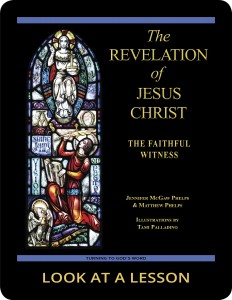 The Revelation of Jesus Christ: The Faithful Witness, a 23-lesson Catholic Bible study with an imprimatur, examines ways in which our traditional Christian view of heaven is built on Hebrew apocalyptic visions recorded in the Old Testament. This recently revised study includes maps and additional commentary and takes a close look at the role of the prophets in present-day Christianity. Illustrations by Tami Palladino depict the often-misunderstood images in the book of Revelation. Click on the book’s cover to view a sample lesson.
The Revelation of Jesus Christ: The Faithful Witness, a 23-lesson Catholic Bible study with an imprimatur, examines ways in which our traditional Christian view of heaven is built on Hebrew apocalyptic visions recorded in the Old Testament. This recently revised study includes maps and additional commentary and takes a close look at the role of the prophets in present-day Christianity. Illustrations by Tami Palladino depict the often-misunderstood images in the book of Revelation. Click on the book’s cover to view a sample lesson.
start a Turning to God’s Word Bible study
 Thank you for your interest in Scripture & the Rosary: New Testament Mysteries, Old Testament Parallels.
Thank you for your interest in Scripture & the Rosary: New Testament Mysteries, Old Testament Parallels.  Information about beginning a Turning to God’s Word Bible study can be found at start a Bible study. Tami, Matthew, and I are available to answer your questions and to offer support. You may use this email to contact us directly if you’re interested in starting a Turning to God study or in having your study schedule listed with other TtGW study groups on our website. —Jennifer
Information about beginning a Turning to God’s Word Bible study can be found at start a Bible study. Tami, Matthew, and I are available to answer your questions and to offer support. You may use this email to contact us directly if you’re interested in starting a Turning to God study or in having your study schedule listed with other TtGW study groups on our website. —Jennifer
*There are seven deuterocanonical books in the Old Testament—the Books of Tobit, Judith, Wisdom, Sirach, Baruch, and First and Second Maccabees, as well as some passages in the Books of Esther and Daniel. Protestants usually refer to these works as “apocryphal,” a word that means “outside the (Protestant) canon” because they’re excluded from most Protestant Bibles. The word “deuterocanonical” means “second canon”; Catholics use that word to refer to any section of the Catholic Old Testament for which there are no extant, or existing, Hebrew manuscripts. All of the deuterocanonical books appear in the Septuagint, the earliest remaining versions of which date to the 1st century B.C. This Greek translation of the Old Testament was in common use by Jews at the time of Jesus—but the same books aren’t found in existing Hebrew manuscripts, which aren’t as old as the oldest version of the Septuagint. Learn more by reading How Do Catholic & Protestant Bibles Differ?
Turning to God’s Word printed Bible studies use the 2006 Revised Standard Version Second Catholic Edition (RSV2CE) translation for all Scripture references except those to the Psalms, which are taken from The Abbey Psalms and Canticles, prepared by the Benedictine monks of Conception Abbey and published in 2020 by the United States Conference of Catholic Bishops (USCCB). All Scripture links for the digital version of Scripture & the Rosary: New Testament Mysteries, Old Testament Parallels are to the 1966 Revised Standard Version Catholic Edition (RSVCE) translation. The New International Version (NIV) audio recordings follow the same chapter and verse numbering as the RSV Catholic translations, but the NIV translation doesn’t include the deuterocanonical books and passages.
The 1966 RSVCE uses archaic pronouns and verb forms such as “thee,” “thou,” “didst” in the Psalms and in direct quotations attributed to God. The 2006 RSV2CE replaces those with more accessible English. The few significant translation changes in the RSV2CE include rendering almah as “virgin” in the Book of Isaiah 7:14 and restoring the term “begotten” in the Gospel According to John 3:16.
Numbering varies for some passages in this Bible study. Turning to God’s Word studies follow the numbering in the Revised Standard Version Catholic translations (RSV2CE and RSVCE). Discrepancies in the New American Bible Revised Edition (NABRE) are noted in the Index of Scripture Citations.
 You can learn more about the Psalms by viewing a sample lesson from the Turning to God’s Word Catholic Bible study Sing a New Psalm: Communicating with God Through the Prayers of the Church—Volume I: Lauds & Vespers. The second part of that study, Sing a New Psalm: Communicating with God Through the Prayers of the Church—Volume II: Vigils, Day Prayer & Compline, is scheduled for publication in 2025. Some verse numbers may vary in different translations of the Psalms.
You can learn more about the Psalms by viewing a sample lesson from the Turning to God’s Word Catholic Bible study Sing a New Psalm: Communicating with God Through the Prayers of the Church—Volume I: Lauds & Vespers. The second part of that study, Sing a New Psalm: Communicating with God Through the Prayers of the Church—Volume II: Vigils, Day Prayer & Compline, is scheduled for publication in 2025. Some verse numbers may vary in different translations of the Psalms.
